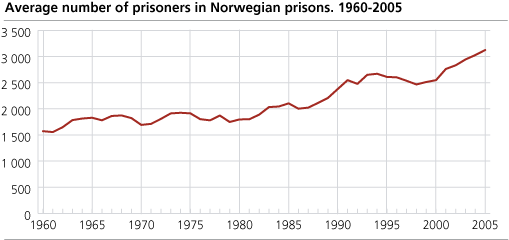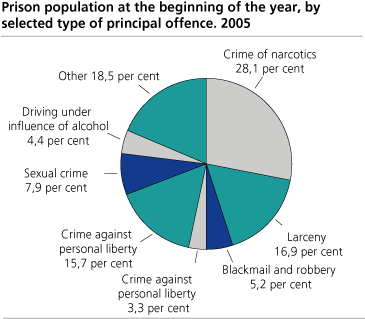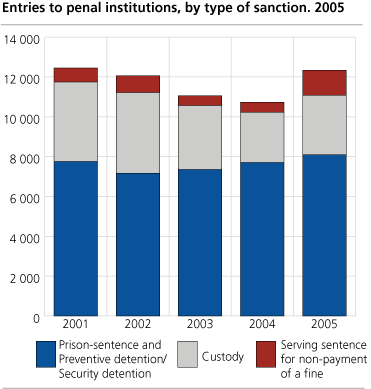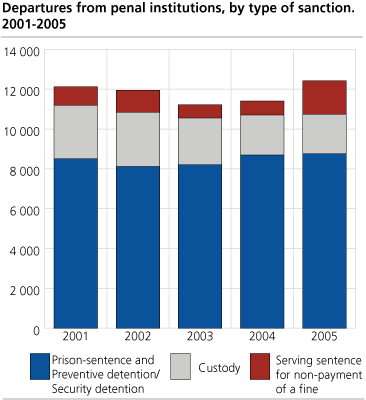Content
Published:
This is an archived release.
Increasing prison population
In 2005, the average prison population in Norway exceeded 3 100 in total. This is an increase of 3 per cent from the previous year - and 13 per cent since 2001. Also in 2005, the yearly average number of prisoners in custody followed the downward tendency from 2002.
On an average day in 2005, 2 354 persons served prison sentences, 76 were on preventive detention/security detention, 585 were in custody and 109 were serving sentences for non-payment of a fine. Compared to the previous year, 3 per cent more persons were serving prison sentences and preventive detention/security detention. On the contrary, the average number of prisoners in custody , decreased by 5 per cent from the previous year, and is 4 per cent lower in 2005 than in 2001.
Those serving a sentence for non-payment of a fine spent 39 946 days in prison in 2005, 22 617 more days than the previous year - which also equaled to about two third of the increase in the total number (see textbook on serving sentence for non-payment of a fine).
More imprisoned for crimes
On 1 January 2005, the population in Norwegian prisons was 3 170. 2 870 of these had a crime as principal offence, an increase of 9 per cent from the previous year. With this, those imprisoned for crimes make more than 90 per cent of all prisoners. Compared to 2001, there were 35 per cent more serving in prison for one or more crimes. 211 were imprisoned for one or more misdemeanours.
Of all prisoners at the beginning of the year, most had narcotic crime1(29 per cent), crime of violence2(20 per cent) or larceny (17 per cent) as principal offence. Those imprisoned for sexual crimes (8 per cent), blackmailing and robbery (5 per cent) and driving under the influence of alcohol (4 per cent) also represented a considerable share (see figure and text box on unstated offences). 149 persons were in prison for murder, where of 25 in custody.
Forty-year-olds increase the most
Compared to the previous year, in 2005 we saw an increasingly number of prisoners in all age groups, except for those who were 50 years or older. Those aged 40 and older had the steepest rise, with 22 per cent. With this, the share of 40-year-olds increased from 17 to 19 per cent of the total prison population. The share of prisoners aged 30, decreased on the other hand from 36 to 33 per cent. In 2005, the thirty-year-olds represented 32 per cent of total prison population, equal to 2004. The moves compared to the previous year were mainly due to changes in distribution of men by age.
More prison sentences and custody
During 2005, 11 900 new imprisonments to Norwegian prisons were registered. A little more than 7 700 new imprisonments applied to serving prison sentences, which was 6 per cent more than the previous year. With this, the share of new imprisonments to serving sentences made 65 per cent of all imprisonments, on contrary to 61 per cent in 2001 (see figure and textbox on serving sentences for non-payment of a fine).
After a reduction of the imprisonments to custody in the period 2002-2004, in 2005 there was an increase of 18 per cent from the previous year, to almost 3 000 imprisonments. The increase in imprisonment to custody were regarded most age groups. The rise was steeper for men than for women, and steepest for men in the age group 21-24 years, 30-39 years and 50 years and over. For women, the increase regarded the forty-year-olds and women in the age 18-20 years.
Compared to the previous year, there were 20 per cent more imprisonments to custody with larceny as principal offence. The largest increase was 37 per cent, for violent crimes. Respectively 18 and 5 per cent reduced imprisonments to custody, with sexual- and narcotic crimes as principle offence from the previous year.
In 2005, imprisonments to custody represented one fourth of all imprisonments, on the contrary to one third in 2001 (see textbox on serving sentences for non-payment of a fine).
Most discharged after full time
In 2005, there were 12 000 discharges from prison, 9 per cent more than the previous year. This was due to an increase in the number of cases of serving sentence for non-payment of a fine (see textbox on serving sentences for non-payment of a fine). The number of discharges from prison sentences and custody remained at the same level as in 2004 (see figure). Among the prison sentences, there were 2 per cent less conditional discharges and 2 per cent more definitive discharges. Two third of all discharged prisoners served full time of their prison sentences. Furthermore, 95 per cent of those serving a sentence and 98 per cent of custody prisoners were discharged before one year in institution.
A higher number of shorter and longer custodies
When it comes to discharges from custody, 63 per cent were completed within a month, in number an increase of 3 per cent from the previous year. Fewer were discharged from custody with time in institution beyond one month, but shorter than one year. On the other hand, for the longest custodies (exceeding one year) the number of discharges was almost doubled, from 23 in 2004 to 45 in 2005.
For the transfers from custody to serving a sentence, there was a gradual move towards shorter time in custody - where 21 per cent served less than 30 days, on the contrary to 19 per cent the previous year.
|
Serving sentence for non-payment of a fine
In October 2004 an altered routine for the practice of calling up those serving sentence for non-payment of a fine was introduced. The change consisted in The Norwegian National Collection Agency (NCA) passing over unpaid fines to The Norwegian Correctional Services for calling up to subsidiary imprisonment after three year instead of the previous four years. At this, custody deductions legally valid annual 2001 and 2002 were passed over to the police districts in 2005, i.e. two annuals in 2005. This involves a larger number of days spent on serving sentence for non-payment of a fine - plus prisoners to, entries to and departures from serving sentence for non-payment of a fine in 2005. The irregular large number is of essential importance to comparison with other years, particularly for those serving sentence for non-payment of a fine, and for the total prison population, entries to and departures from in general.
Most offences are known
In 2004, the level of filling in has improved considerably. In 2005, the whole prison population and almost all new imprisonments and discharges have a known principal offence. However, a few prisoners were registered with unknown offence, among other things because some of these were imprisoned for offences according to penal legislation in another country. |
1Included crime against the Act relating to Medicinal Products and Poison etc.
2Total for the Penal Code, chapter 12 (Assaulting public servant), 21 (Crime against the personal liberty) and 22 (Crime of violence against the person).
Tables
Contact
-
Susanne Fjelldalen
E-mail: susanne.fjelldalen@ssb.no
tel.: (+47) 40 90 26 43
-
Kristin Bergvall
E-mail: kristin.bergvall@ssb.no
tel.: (+47) 92 66 55 13
-
Reid Jone Stene
E-mail: reid.jone.stene@ssb.no
tel.: (+47) 99 02 22 01




